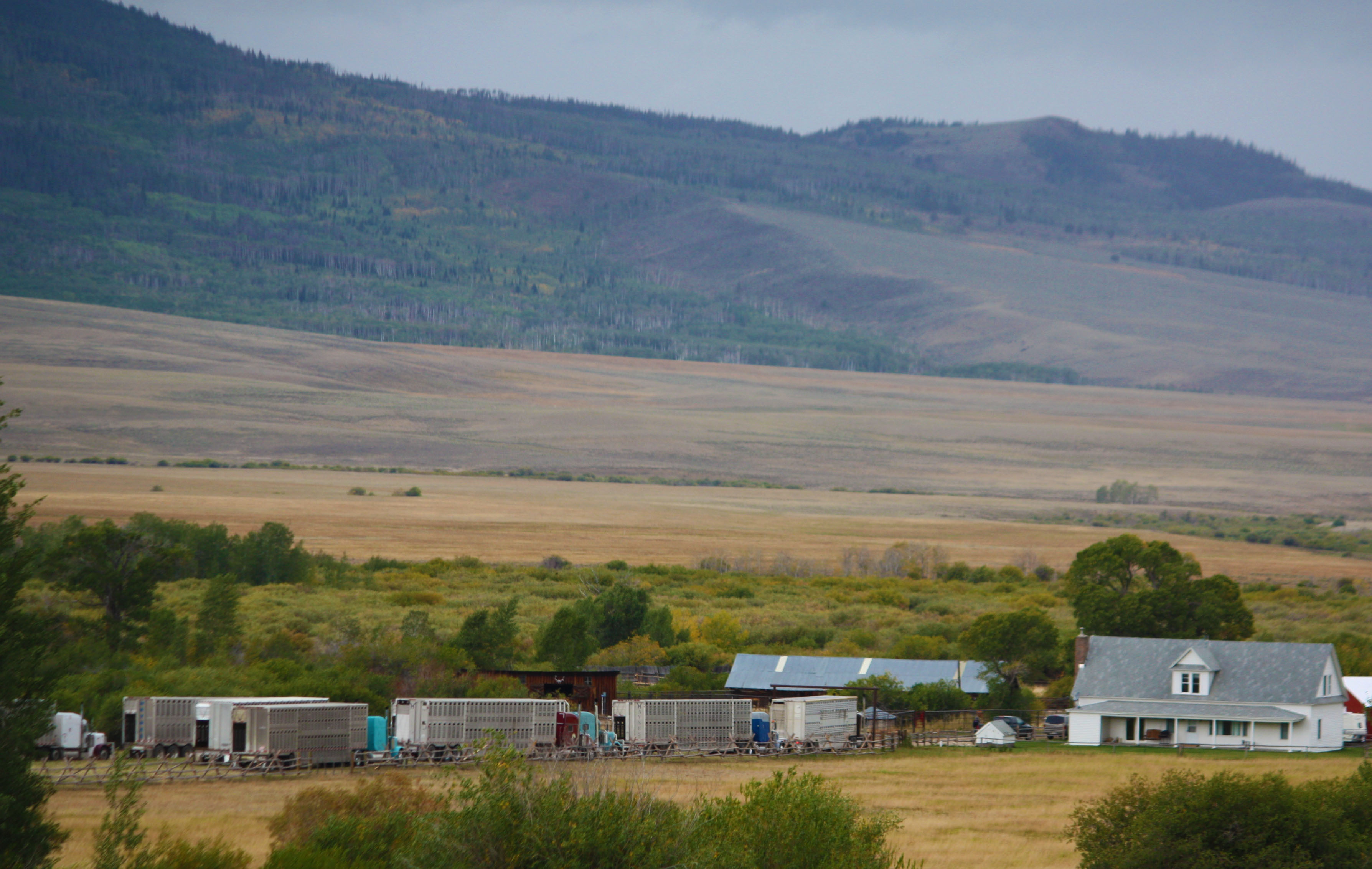
Cattle trucks line up at the gate of the Basin Ranch.
The changing of leaves in the fall signals many things. When most are getting into the swing of the school year, fall sports, and preparing for hunting season, ranchers are gearing up for the unique and busy experience that is shipping season.
For those who may not be familiar with this practice, shipping season is the process of gathering cattle at one location, loading them into large trucks and driving them from the ranch to another location for the season or to feedlots. I was able to visit and witness most of this process in September at the Basin Ranch outside of Elk Mountain, Wyoming.
The ranch is owned by Fred Eshelman. Eshelman partnered with the Wyoming Stock Growers Land Trust (WSGLT) to conserve the property in 2012, and has since conserved three additional Elk Mountain Ranches with WSGLT. The ranches run a combination of yearlings and cow-calf pairs totaling around 10,000 head of livestock.
The Basin is managed by Paul Cook, with the help of his wife Beth and their family. The morning I visited I met with two of the ranch employees; Shelly Bradford, the outgoing secretary and bookkeeper and Heidi Hess, who will be taking over for Shelly. We drove down a dirt road following what seemed like an endless flow of semi-trucks with silver livestock trailers attached.
Armed with warm clothes and a camera, I was introduced to everyone who was helping with the shipping process, which included around 20 people. We walked up to a set of corrals where a few of the cattle bawled and cowboys and cowgirls joked and laughed from the backs of their horses as rain came down sideways. As Beth handed a cup of coffee to one of the riders she commented, “If Christmas is a marathon, shipping is a sprint.”

Paul Cook and Cris Williams ponder a plan for the next pen of cattle.
I quickly learned that a sprint was the best possible description of the event. In one day, the crew would sort out around 750 head of cattle out of the main herd to be loaded onto trucks to head to Colorado. This process would continue for three more days until all 4,500 head of cattle were headed to their destination. This 4-day process is the pay day for the ranch and the culmination of months of hard work and planning by Paul and his family.
Shipping is part of a one of a kind lifestyle for the Cook family. Paul and his family had been preparing for weeks for this. Meal plans and schedules had been made, cattle had been worked and sorted, and help found.

Paul Cook, Jed Rourck, and Cris Williams sort cattle out to load onto the next truck.
Cook spoke about what makes shipping a large number of cattle look like an art form, “The key to running it smoothly is to get good help. Every one of those guys knows the importance; we work all year for this one day…” Cook continued, “Every one of these guys knows that, and knows the importance because it needs to go just perfect.”
From the corrals to the books, every detail is perfected and accounted for. Once all of the semi-trucks had gone and everyone had been fed a hearty meal made by the family, Paul and Beth sat down with Shelly and Heidi to look over the accounting portion.
Paul pulled out a pocket planner and they went over the numbers for the day. Cattle that were accounted for, cattle that had been lost, and the terms of the management contract; no detail was overlooked and the business for the day had been completed.

Paul and Shelly working on the numbers from the day.
That’s when Paul took a moment to speak with me about his family’s experience on the Basin Ranch. We sat in the mudroom among dozens of pairs of cowboy boots, hats and silk scarves. “Fred made a comment one time.” Paul reminisced, “He said, ‘I picture you as vanishing America.’” “We are very family oriented. We eat every meal together, the kids and Beth are able to go with me and work with me every day.” Cook explained along with working on the ranch, the couple values education and utilizes an online program to home school the children. Home schooling works well for the family as the ranch is very isolated and the kids are able to grow through a combination of traditional education and ranching education. “There’s probably no better feeling than being able to go out there every day and working with your kids. That’s what makes a lot of this [worthwhile] it’s for that family time and, of course, being able to enjoy what we do.”

Paul gives directions to a group of riders. Pictured: Paul Cook, Donnie Painter, Lance Cook, Shaylee Cook, Cris Williams and Jed Rourck.
Paul spoke about how the conservation easement ensures that the ranch will remain undeveloped allowing his family to continue to do what they love. “I love what I do; we have a tremendous opportunity, me and my family, to be able to work for Fred and look out and see it [the ranch] as it was a hundred years ago.”
I thanked Paul for allowing me to tag along for the day and for allowing WSGLT to document the shipping process. Although my work day was coming to a close, his continued as he, his family, and friends went back into the rain to check and care for the cattle.
As I stood in the emptying mud room I realized that I was watching vanishing America go back to work with smiles on their faces because they are doing what they love, on a ranch that will never disappear.

Paul Kenner waits to drive cattle up the alley and onto the truck.

